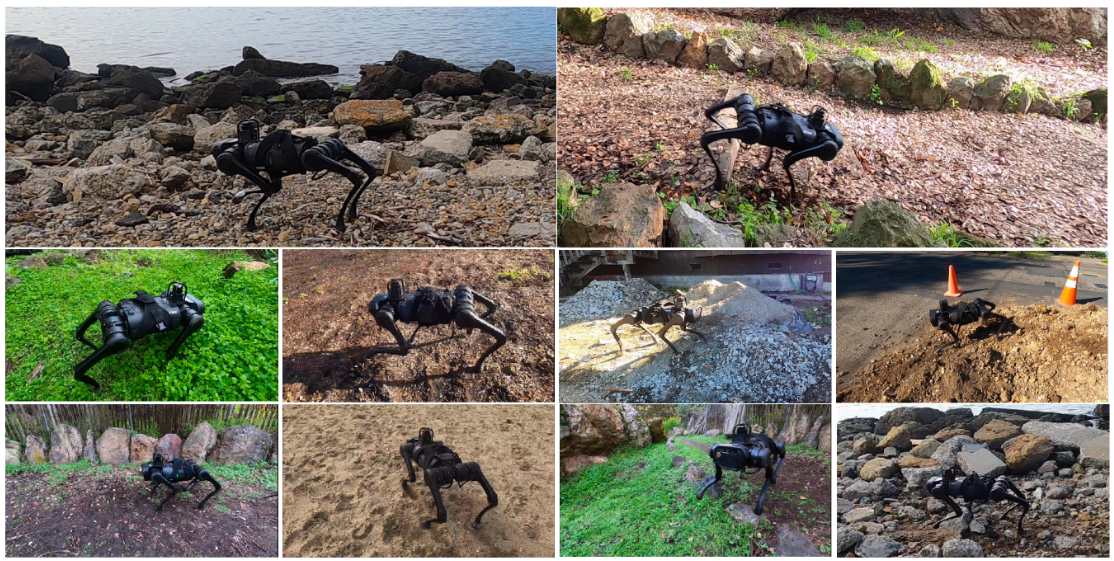 AI
AI
 AI
AI
 AI
AI
Facebook Inc.’s artificial intelligence researchers have come up with a more advanced method of teaching walking robots to adapt to different kinds of terrain on the fly.
Using the method, robots can with relative ease make their way across sand, loose rocks, deep grass, muddy fields, slippery surfaces and anything else they encounter.
The Rapid Motor Adaptation method of teaching robots to adapt to their environment was developed in collaboration with researchers from the University of California at Berkeley and Carnegie Mellon University. It also helps robots to react to other changes they may experience while walking, such as if a heavy weight is suddenly thrown upon them.
AI researcher Ashish Kumar from UC Berkeley, along with his colleagues Zipeng Fu and Deepak Pathak from Carnegie Mellon and Jitendra Malik from Facebook AI Research, said in a blog post that RMA will help make robots more effective in situations such as a search and rescue operations. Up until now, walking robots have struggled to adjust for the countless changes in their environment that they must contend with, which include different types of surface, slopes and obstacles in their path.
Previously, robots were taught to cope with different terrains through a series of sophisticated hand coding and learning techniques. Facebook said RMA combines a base policy trained through reinforcement learning with an adaptation module trained using supervised learning to help robots teach themselves about their surroundings and how to adapt to them instantly.
“The base policy is learned in simulation with real life, using carefully curated information about different environments (like the amount of friction and weight and shape of the payload),” the researchers explained. “We set different variables — simulating more or less slippery ground or the grade of an incline — so it learns the right controls for different conditions, and we encode info about those variables as ‘extrinsics.’”
The base policy isn’t enough, though, as the actual extrinsics the robots will encounter in the real world aren’t known. So RMA also relies on information that the robot teaches itself about its surroundings, based on its most recent body movement. For example, if the robot suddenly comes across a softer surface such as mud, its leg will extend further as its foot sinks into the ground, whereas on a harder surface its leg would stop sooner.
The base policy then helps train the adaptation module, based on this information, to teach the robot how to adapt almost instantaneously.

“RMA is the first entirely learning-based system to enable a legged robot to adapt to its environment from scratch, by exploring and interacting with the world,” the researchers said. “With this combination of a base policy and an adaptation module, the robot can adapt to new conditions in fractions of a second.”
One clear advantage of the RMA method is it helps robots do more than just adjust to different terrain. It allows them to take into account things such as wear and tear, such as a dent that appears on its foot or worn-down parts in its leg, for example. It can even help a robot adjust instantly for the weight that’s thrust upon it if it has to pick up an injured person during a rescue operation.
The researchers said that experiments have shown RMA-enabled robots outperforming non-RMA bots in numerous kinds of challenging terrain, including sand, mud, hiking trails and even a dirt pile.
“The robot successfully walked down stairs along a hiking trail in 70% of the trials,” the researchers wrote. “It successfully navigated a cement pile and a pile of pebbles in 80% of the trials despite never seeing the unstable or sinking ground, obstructive vegetation or stairs during training. It also maintained its height with a high success rate when moving with a 12kg payload that amounted to 100% of its body weight.”
The researchers said they believe RMA could be transformational in the world of robotics, helping to create a new generation of more advanced, adaptable walking robots. The most obvious application is in search and rescue operations in areas that might be too dangerous or inaccessible for human rescuers. But there are other applications too — for instance, maintenance robots that need to work in remote locations and also military applications.
Analyst Holger Mueller of Constellation Research Inc. said the development of RMA is exciting because intelligent adaptation is one of the key challenges that AI has struggled to overcome.
“Now Facebook and its research partners have finally achieved this, and it is a big milestone,” he sad. “It has made real progress in an automation area that has not previously been given much attention by deep learning researchers. It’ll be fun to see how robot makers in the real world can use this new AI framework.”
Beyond robotics, RMA also highlights the potential of building other kinds of AI systems that can adapt to numerous changes they face in real time, simply by leveraging data on the fly to understand the context in which an algorithm operates.
“This is a broad, long-term challenge that will require progress in many subfields beyond reinforcement learning,” the researchers said.
THANK YOU